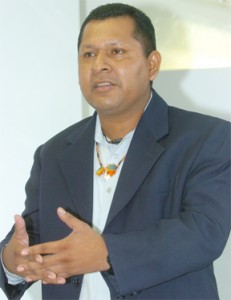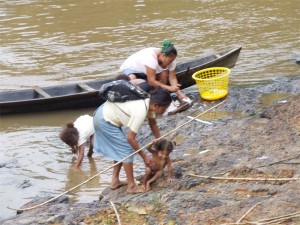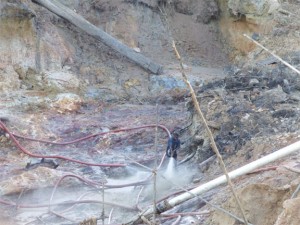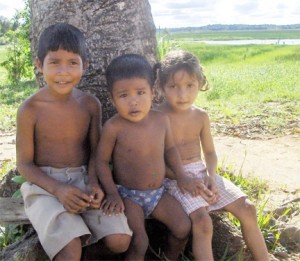David James is an Amerindian, an Attorney-At-Law and an informed, passionate and articulate advocate of the rights of the indigenous peoples of Guyana. In this interview with the Guyana Review the former President of the Amerindian People’s Association (APA) and the APA’s legal adviser argues that Amerindians must exert more collective “pressure” if they are to secure their full rights as Guyanese. including their right to a genuine say in the environmentally responsible management of Guyana’s mineral and timber resources.
Guyana Review:
Which are the most critical ways in which the environmentally unsound exploitation of mineral and timber resources have affected the way of life of the Amerindians and their communities?
David James
 The environmentally unsound exploitation of the mineral and timber resources of Guyana have affected the way of life of the Amerindian people in various critical ways. Principally, we have witnessed environmental degradation which includes damage to the rivers, streams and lakes which are the sources of fresh water and food – in the form of fish – for most communities. There have also been a number of studies which show that Amerindian communities have been affected by mercury pollution which is a direct consequence of gold mining.
The environmentally unsound exploitation of the mineral and timber resources of Guyana have affected the way of life of the Amerindian people in various critical ways. Principally, we have witnessed environmental degradation which includes damage to the rivers, streams and lakes which are the sources of fresh water and food – in the form of fish – for most communities. There have also been a number of studies which show that Amerindian communities have been affected by mercury pollution which is a direct consequence of gold mining.
With regard to forest exploitation a number of Amerindian communities have been victims of poor agreements resulting in companies’ harvesting in an unsustainable manner. Last May we had a clear example of this in the village of Akawini where the villagers complained about very poor environmental practices, including over-harvesting that resulted in damage to the forests, the ollution of the rivers and creeks in the area through residue from the timber harvesting activity and the destruction of hunting grounds. That was a clear case of indifference to the rights of the indigenous people by a major company. The matter was made public and the company withdrew after the villagers made it clear that they wanted them to leave.
Guyana Review
Do the affected Amerindian communities regard themselves as victims of those activities or have they simply learnt to live with them?
David James
Those communities that have borne the brunt of the environmental damage are very resentful. They are resentful of the social effects of mining and timber harvesting – especially mining – which include the introduction of large amounts of alcohol, illicit drugs and prostitution camps. These activities take place either within the mining areas or close to the mining areas.
There are cases in which some communities are so resentful of these practices that they have sought legal redress. There are at least three cases that I am aware of where communities have initiated legal action to protect their rights. The success in these cases has been limited primarily because the court process is very slow.
What the communities feel is that their protection is best assured through the granting of full rights including sub—surface rights. This would mean that they would have full ownership of the resources and better control of those resources. Of course access also means that they would benefit from those resources.
Guyana Review
There is a school of thought that says that it is the inability of the authorities to effectively enforce existing laws designed to guard against harmful mining and logging practices that has made the problem worse. To what extent do you subscribe to this view?
David James
There is a serious deficiency with the enforcement of existing laws. If you speak with the Guyana Geology and Mines Commission (GGMC) they complain of a lack of human resources and the expense associated with getting their officers into the regions. There is a very clear recent case of Mines Officers going to a particular village and issuing a cease order to miners to stop them working in a particular area and as soon as the officers left the miners started to work again, around the clock. The fact is that the GGMC cannot enforce the rules effectively since there is no one on the ground to ensure adherence to those cease orders. The officers issue the orders and then they leave.
Guyana Review
Amerindian lobbyists have, for many years, been seeking to make an argument for sub-surface rights to go along with titles to their ancestral lands. How effective are the land titles in the absence of sub-surface rights?
David James
Amerindian lobbyists have been lobbying for over a decade and a half on the question of having sub-surface rights being protected under the law. We have been able to influence slight legal change in this regard. Section 47 of the Amerindian Act now contains what I would describe as limited protection of our right to free, prior and informed consent which is recognized under international law as a prerequisite for any activity that is carried out on indigenous peoples’ lands.
Under Section 48 of the Act the villages that have title now have the right to consent to small and medium scale mining on their titled lands.
Unfortunately this right does not extend to untitled communities. This, of course, is a serious deficiency.
 At the same time, under the law, the GGMC is not required even to consult with the villages far less secure their consent before granting a mining concession, even on titled land. All that the GGMC has to do is to notify the village and to satisfy itself that the effects of mining will not be harmful; and, of course, the GGMC does not have the personnel or the resources to make such a determination nor indeed is there a standard that has to be met.
At the same time, under the law, the GGMC is not required even to consult with the villages far less secure their consent before granting a mining concession, even on titled land. All that the GGMC has to do is to notify the village and to satisfy itself that the effects of mining will not be harmful; and, of course, the GGMC does not have the personnel or the resources to make such a determination nor indeed is there a standard that has to be met.
I recall writing to some miners explaining that the Amerindian Act required that they secure the consent of the villages. What we have is a contradictory situation where the GGMC grants mining permits to miners who then go to the villages ostensibly to seek permission. Usually, however, their approaches are, in fact, demands that are backed by the permits that they would have received from the GGMC.
The state and not Amerindians hold sub-surface rights and the miners usually take the position that it is the GGMC that has the last word in the matter.
Unless the communities know their rights under the law they are not in a position to defend those rights; and usually they don’t know their rights in this regard. The Amerindian lobby groups have been engaged in rights education and rights awareness over the past fifteen years and more communities are now taking action including legal action to assert those rights.
The state as represented by the government also has a duty to ensure that the rights of indigenous people are protected. Unfortunately, what we have been seeing since independence is that governments, generally, have been very recalcitrant, very slow in responding to rights protection in policy and legislation. Even where legislation has been enacted, enforcement and monitoring are usually very weak.
Guyana Review
Do Amerindian communities accept the importance of mineral and timber exploitation as critical national economic activities or do they simple wish to be left alone to utilize the lands as they see fit?
David James
Most indigenous communities that I have worked with accept the national economic significance of the country’s mineral and timber resources and the importance of its exploitation for the national good. What is important to note however is that traditionally, the indigenous communities have used these resources in a sustainable manner. In the forestry sector, for example, it is not just timber products that are important but also non-timber products including medicinal plants, craft and other pursuits that do not involve the felling of trees. Of course there are some villages that do small-scale logging but the traditional approach to exploiting forest resources does not include the large scale felling of trees.
For as long as we can remember there are also indigenous communities that have been engaged in artisinal mining that usually employs the battel and the shovel. Some of that has changed. I know of one village – Jawalla in the Upper Mazaruni – which is involved in quite a bit of mining. What I have seen is that they have used some of the proceeds from mining to build facitities like a school and a Health Centre and other facilities for the village. In that regard mining has redounded to the benefit of the village.
Guyana Review
How effective have the various Amerindian lobby groups been in their efforts to curb the worst excesses of environmental destruction resulting from mining and timber activity?
David James
The Amerindian lobby groups have been effective to some extent in curbing some of the worst excesses of damage to the environment. We have also had a fair effect on policy. If we look at the constitutional reform process the Amerindian People’s Association (APA) was involved in mobilizing several communities to make submissions to the Commission and we were able to get articles into the constitution Article 149 (G) which speaks about the rights of the Amerindian people, the promulgation of their languages, their culture any their way of life. We also made submissions in respect of the Amerindian Act and mobilized people to make submissions to the committees that went out to consult with the communities.
While the Act did not, eventually, reflect a lot of those recommendations, the recommendations are there on record to be used to improve the present Act because that is what is needed. There are certain very important provisions in the Act that have to be amended to bring it line with international standards that govern the rights of indigenous peoples. So we have had some successes.
Guyana Review
As an Attorney – At- Law what is your own thinking on the effectiveness of the existing laws and enforcement procedures designed to protect Amerindian communities from harmful effects of logging and mining?
 David James
David James
There is a need for the Amerindian Act to be amended particularly because in 2007 the United Nations Declaration on the Rights of Indigenous Peoples was approved by the General Assembly. That Declaration ought to be the guide for legislative reform in any country. The Amerindian Act was passed before that Declaration was approved but the approval of that Declaration essentially means that those states that have voted for it are saying that they consent to abide by its very lofty principles. Therefore, the Amerindian Act as it stands now falls far short of many of the rights standards that are contained in the United Nations Declaration on the Rights of Indigenous Peoples. In this regard I think that what we need are amendments to certain key sections of the Amerindian Act to bring it in line with the UN Declaration on the Rights of Indigenous Peoples and other international standards and international human rights law governing indigenous peoples. These amendments need to pay particular attention to the lands, territories and resources of the indigenous peoples which they have traditionally occupied for centuries. It is only when there is legal recognition of those territories that we can exercise the necessary jurisdiction over them. Here I also include sub-surface rights. International law recognizes that sub-surface rights should go to indigenous peoples but there has been a reluctance on the part of most states, including Guyana, to put that in the relevant legislation.
Guyana Review
Where do you see the discourse on the impact of mining and logging on Amerindians and on the environment going in the short to medium term?
David James
In the first instance there is no discourse or debate. What we have is a confrontational environment. There is an apparent unwillingness on the part of government and its agencies to include Amerindian leaders and organizations in the formulation of mining policy and the management of the mining sector. You have to include indigenous people in the management of the mining and forestry sectors since it is they who are directly affected by mining and forestry activities. Amerindians therefore must have an equal say in decision-making in these sectors. Until this happens the relationship will continue to be informed by confrontation. This is bad both for the country and the economy.
What we would like to see in the short to medium term is a change in the current approach to the management of these sectors. I think that any new management arrangement for these sectors must, of necessity, include the indigenous peoples.
My strong opinion is that indigenous peoples have to exert enough pressure to secure an effective voice in our country. We have to organize ourselves to the extent that we acquire a unified voice with which to exert the necessary influence on the decision-making mechanisms within the country. We make up ten per cent of the population and we comprise the large majority of the population in the hinterland. We therefore need to exert enough pressure to justify what we represent. One of the ways in which this can be done is through the National Touchous Council which is a statutory body under the Amerindian Act. The problem here is the danger that the Council could simply become a body that is mainly influenced by the Amerindian Affairs Ministry and rather than genuinely representing the interests of the indigenous peoples they may simply mouth those issues that are determined by the Ministry. I believe, however, that this body has the potential to become an effectively force in representing the interests of the indigenous peoples of Guyana. Additionally, there is the Indigenous People’s Commission which is a constitutional commission which is there in the constitution but is yet to be actually established. I believe that this Commission can play a very important role in bringing to national attention the various pressing and urgent issues that affect indigenous peoples.







